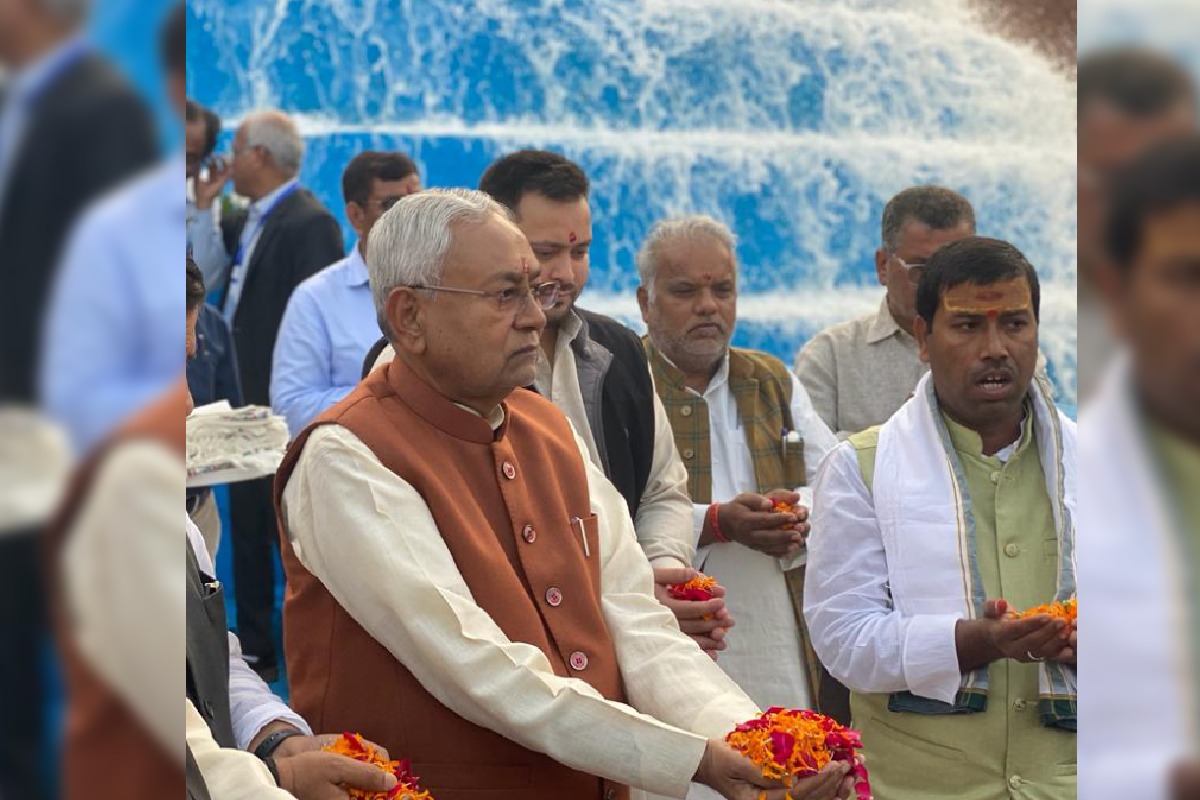


Giving a mega boost to one of the ambitious projects of Gangajal Aapurti Yojana, Bihar Chief Minister Nitish Kumar on Sunday inaugurated country’s first of its kind project to store, treat, and supply floodwaters of the river Ganga the state receives during the monsoon months to cities like Gaya, Rajgir and Bodh Gaya, popularly known as Buddha Circuit.
The Chief Minister inaugurated the project built at a cost of Rs 4,000 crore that will supply the treated floodwater of river Ganga.
The project, initiated under the Jal Jeevan Hariyali mission, is the dream project of the Chief Minister, who is also a Janata Dal (United) leader along with his deputy Tejashwi Yadav.
WhatBihar CM @NitishKumar has to say on one of his dream projects 'supplying treated flood water of river Ganga' to cities like Gaya, Bodh Gaya & Rajgir.
He says this project will recharge the ground water in Rajgir & thus help in irrigation. @TheNewIndian_in 📹 @amitrawat31120 pic.twitter.com/7eiyaYlp3x— Anand Singh (@Anand_Journ) November 27, 2022
After inaugurating the project, Nitish Kumar said that the project will help the people of Rajgir and Gaya to get drinking water and it will be provided to government quarters, homes, hospitals and hotels.
This floodwater will be stored here in the reservoir that will be treated and then it will be sent to Rajgir from here, he said, adding that he will inaugurate the treatment plant of Bodh Gaya that will ensure the supply of water to Gaya and Bodh Gaya both.
“And next year we will provide water to Nawada district too,” the Chief Minister said.
To a question by The New Indian about when the state government plans to provide water for irrigation as Nalanda district faces draughts like situation every year, Nitish Kumar said, “Irrigation requirements too will be fulfilled as the water table of these areas will improve due to storage of water in huge capacity here. And it will help people in irrigation here.”
He also said that 135 liter per day of drinking water will be provided to every family with five members.
He also stressed that due to the first such project in the country it will help us in dealing with the issue of floods as its water will be treated and applied for drinking water.
According to the state government, the project will store, treat, and supply the floodwaters of the river Ganga the state receives during the monsoon months.
The initiative has two objectives. First, it conserves floodwater, preventing wastage, and second, it transforms this precious resource into safe, drinkable water, the state government said.
Megha Engineering & Infrastructures Ltd (MEIL) was awarded the tender for the project which was completed in a recorded time of two and half years, despite challenges during the Covid-19 pandemic.
MEIL Director CH Subbaiah told The New Indian that this floodwater will be lifted through pumps at Hathidah and transported through a 151-kilometre pipeline to three enormous reservoirs in Rajgir, Tetar, and Gaya.
“These reservoirs stand out as they have been constructed based on the terrain and using natural materials. Water from the reservoirs will travel to two Water Treatment Plants (WTP), where it is treated and transported to the enlightenment cities,” Subbaiah said.
The three south Bihar cities of Rajgir, Gaya, and Bodh Gaya have been experiencing water shortages due to excessive groundwater extraction via bore-wells.
“With the successful completion of the first phase, drinking water requirements of significant locations, such as Nalanda University, IT Park, Cricket Stadium, Film City, Police training camp, Nature Safari, and Zoo Safari, will be fulfilled. In addition, the Ganga Jal will be accessible to well-known temples,” the MEIL director added.
The initiative was taken by Nitish Kumar in 2019 to convert floodwater into drinking water for these areas, which had no access to Ganga water due to their geographical location at a special cabinet in Gaya.
MEIL, which is executing the entire project, created a massive infrastructure.
“Under the first phase, an intake well- cum-pump house was built first at Hathidah in the Mokama area in Patna. From Hathidah, water is sent through a pipeline network to the detention tank built at Rajgir. A total of four pump houses have been constructed. They are at Hathidah, Rajgir, Tetar and Gaya,” Subbaiah said.
“This project has three storage reservoirs with live capacity at Rajgir (9.915 M.Cu.M), Tetar (18.633 M.Cu.M), and Gaya (0.938 M.Cu.M),” the MEIL Director said.
The water is pumped from these reservoirs to three different Water Treatment Plants (WTPs) with varying capacities: Rajgir, with a capacity of 24 MLD; Manpur; and Gaya, with a capacity of 186.5 MLD.In addition, the company has erected two power substations of 132 KV /33 KV and 33 KV /11 KV capacities, laid a 151 km-long pipeline, built four bridges and a Rail Over Bridge. Presently, we are pumping 5 MLD of water as per PHED to Rajgir and supplying 135 LPCD (litres per person (capita) per day)for the population in Gaya and Bodhgaya.